100 Stories
Zipping Across Hatsukaichi – Adventures at Mominoki Forest Park
The city of Hatsukaichi lies just west of Hiroshima, and is known more for the island of Miyajima–what everyone actually comes for–than anything else. It’s true that most of Hatsukaichi’s appeal lies near the coast, but the city limits are broader than most people expect, and sometimes even locals such as myself need to be reminded that Hatsukaichi is also mountainous on the inland side, which means a lot of opportunities to engage in outdoor activities. Although the JR Sanyo Red Line and the number 2 streetcar run past parts of Hatsukaichi, places far from those stations are barely served by buses, so the most feasible way to visit those locales would be by car. Contrary to that, I always seem to find a way around the private automobile journey, and while I can indeed say that the tourist sites of interior Hatsukaichi can be reached by bus and on foot, the walking part comprises the bulk of the commute, so be prepared for a laborious slog if you can’t secure your own vehicle. Ladies and gentlemen, allow me to present to you the story of one such voyage on a tranquil winter morning.
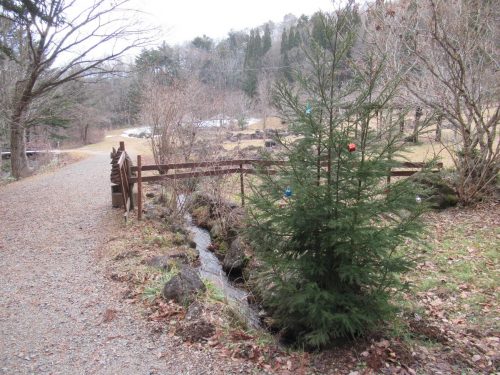
‘Twas the day before Christmas, when all through the hills,
Snow blanketed the roadsides; wind gave us the chills.
Whilst people and wildlife hunkered down at home,
I got on a bus bound for someplace to roam.
- Areas
- Category
Snow Trek
Mominoki Forest Park is a verdant haven where nature enthusiasts can roam the great outdoors and partake in numerous athletic pursuits. Situated in the northwest corner of Hatsukaichi, it’s actually closer to the border with Shimane Prefecture than it is to urban Hiroshima, and busses bound for Masuda in Shimane Prefecture actually swing by the vicinity of the park, albeit not at the park itself. After countless attempts to find a smooth way to reach Mominoki Forest Park by bus, I concluded that the closest bus stop is the Yoshiwa Service Area, a rest stop by the side of the highway with public restrooms and small stores selling food.
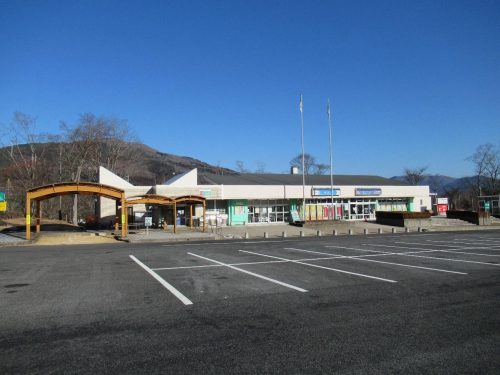
I say that it’s the closest one can get to Mominoki Forest Park without a private car, but from Yoshiwa, it’s still a 105-minute one-way walk. Yes, you read that right; I’m about to walk an hour and forty-five minutes to get to a park in the middle of nowhere before engaging in additional physically demanding activities. Those who go on road trips frequently should already know this, but when it comes to rest areas, for each one, there are typically two locations: one on each side of the highway to serve drivers going in both directions. This applies to the bus too, so when taking the bus back to Hiroshima City, make sure you know the location as well as how to walk to the rest area on the opposite side (free up additional time for finding it on your return journey). To the right of the building above, there’s a path that branches into two roads: the one to the right crossing over the highway (which I’ll use to go home later), and another straight ahead that winds down onto country roads that will take me to my destination.
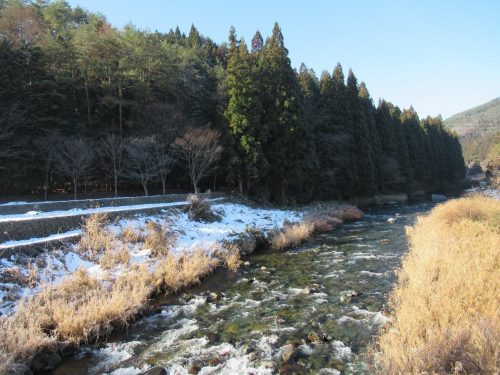
I cheerfully snaked down the path to the local roads, speculating that I’d be lamenting the way back up. Not too long after I passed under the highway from whence I had come, I crossed over this stream, whose banks were covered with snow from the night before, adding to an already colorful landscape. I crossed over the same stream via another bridge and came to a fork just past the Konpira Shrine, at which point I went right. That narrow path merged with a busier road, which I would have to follow for another hour or so before arriving at Mominoki Forest Park.
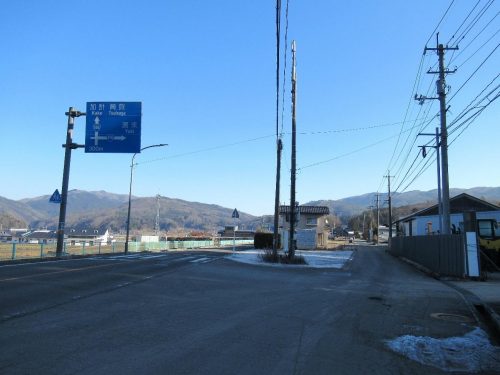
Up until this point, I had been walking through a small town, but eventually, the so-called “town” disappeared, and I was flanked on both sides by nothing but wilderness. This leg of the journey was packed with snow too, but it was nowhere as beautiful as it was by the stream earlier. On top of that, there were no stores or anywhere else to take a break; the only buildings around were just people’s houses and miscellaneous businesses that had long since gone out of business. That said, if you have to relieve yourself along the way (like I did), your only choice is to duck into the snowy woods far from the cars to do your business. Luckily, at this time of year, the snow does a good job concealing human waste, and is also a viable option for washing your hands afterwards, freezing temperatures notwithstanding.
Moment of Joy: Santa Came Early
With my potty break out of the way, I hit the road once again and trudged up the gradual incline leading to Mominoki Forest Park. Overall, it’s an upward hike, but the road dips down and back up multiple times and makes the walk more tiresome. Somewhere in the middle of my grueling climb, a hospitable stranger in a vehicle passed me by and came to a halt, asking me where I was headed. When I told him, he replied that he happened to be driving in that direction, and graciously offered me a ride all the way there. Mere moments ago, I was stressing out over whether I would even make it to the park by noon, but this earthly Santa Claus whisked me all the way to the front entrance of Forest Adventure with over an hour to spare; it was truly a Christmas miracle!
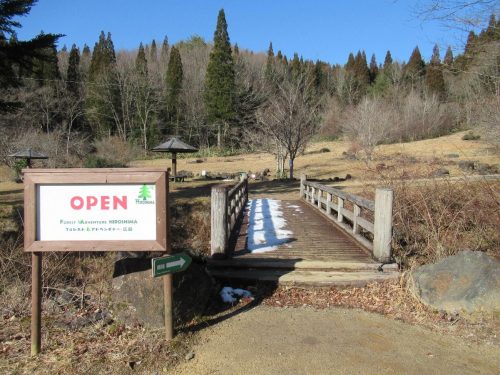
Hilltop Pit Stop
I originally made a reservation for the Forest Adventure ziplining and treetop obstacle course experience at 12 noon, and intended to hop right into the action as soon as I walked to the entrance, but with me getting here so early, I figured I had time to grab some lunch before the action. The nearest restaurant is a brief climb further up the hill in a building called “Mominoki Villa,” where guests can also buy souvenirs and spend the night. I entered the building, turned left, and walked past the gift shop into the restaurant.
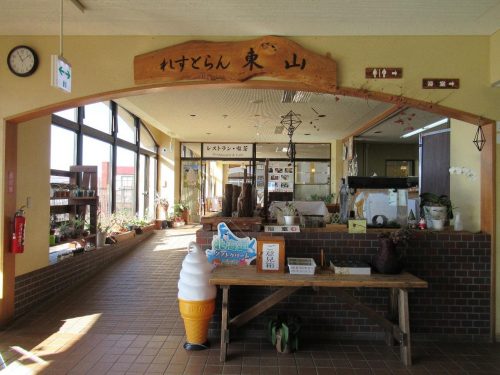
The menu here is pretty modest, and they serve the standard Japanese fare: noodles, rice balls, curry, fried chicken and pork, etc. However, they do serve a couple specialties made with local ingredients, so I went with their wild mushroom kakiage (a deep-fried mass of chopped vegetables and sometimes seafood) rice bowl set. I paid the man, received a numbered token, and sat down to await my order. It felt like a good long while (mostly because I was anxious to make it back to Forest Adventure), but I knew they were making my food to order and that it would come out piping hot and delectable.
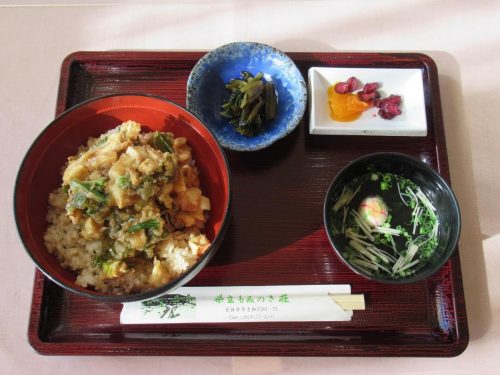
I popped into and out of the restroom to find my meal right at my seat, fresh and waiting to be devoured. The kakiage consisted primarily of mushrooms and spinach, and paired well with the rice and sauce. My rice bowl came with a bowl of clear broth, some Japanese pickles, and some marinated mustard leaves that had a strong wasabi aftertaste. Many of the food items in the gift shop are wasabi-flavored because wasabi is a primary agricultural product of the Yoshiwa area, which probably explains the horseradish kick.
A Playground for Grown-ups
By the time I wolfed down my lunch and ran back down to Forest Adventure, it was twelve o’ clock on the dot, but other participants were arriving at the same time as me, so I didn’t feel guilty at all. There are Forest Adventure locations all over the country, and the courses and services offered differ by branch, catering to adventurers of all ages. Reservations are mandatory no matter what, though, but fortunately, it is possible to make reservations online in English if your Japanese reading skills aren’t up to spec. The setup in the foreground here is geared toward the younger guests (and their parents); the obstacles I would confront are higher and scarier. Nevertheless, one of the effects of the Forest Adventure experience is that people who overcome these daunting trials may conquer their acrophobia or other irrational fears.
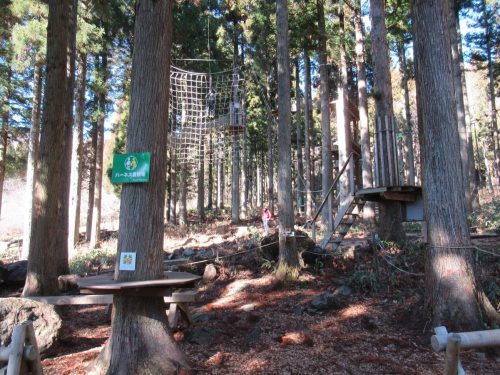
At the reception counter, I confirmed my reservation and read the green sign to understand the rules (written in Japanese and English) before being asked to wait for the other participants. Once everyone was situated, we were led to an area where we put down our baggage for safekeeping (not having a car meant carrying a big rucksack with me) and stepped into our safety harnesses. Gloves are necessary to participate, and I made sure to bring my own, but those who forgot can purchase a pair at the front. This probably goes without saying, but open-toed shoes are not allowed, and since it gets pretty chilly up in the treetops, dressing in layers is highly recommended. Finally, we were loaned a fanny pack in which to store our smartphones and other valuables.

With our baggage stowed away and our equipment on us, we proceeded to the demonstration field, where our guide introduced the pulley and carabiner, taught us how to latch them onto the cable, and demonstrated proper zip lining technique. Before ascending any course, all adventurers attach their pulley to the cable so that there’s never any risk of falling to one’s death below, and the carabiner is attached as well when crossing obstacles. The instructor stressed that when zip lining, a seated posture is required when starting and traveling, but it is paramount to extend the legs at the end of the ride as a braking mechanism as well as to prevent crashes. After detaching yourself from the cable (the zipline is the end of a course segment), wave the orange flag to indicate to the next adventurer that it is safe to jump off. Use of cameras and smartphones is allowed up in the forest canopy, but at the adventurers’ own risk; if you request it, the guide will be happy to take pictures and videos of you as you progress through the course.
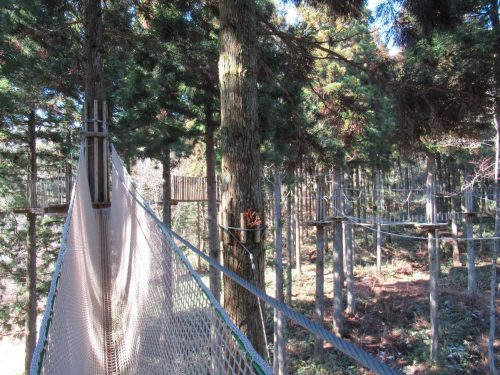
At long last, it was time to climb, so we marched single file to the stairs, attached our pulleys to the railing, and ascended to the canopy. Up here, there were a plethora of obstacles to try our hand at, including–but not limited to–tightropes, suspended wooden platforms, net tunnels, a rock wall, and who can forget the ziplines? Initially, I was hesitant to take the first step, but the more obstacles I tried, the more the procedure became second-nature.
You may have heard people advise, “don’t look down,” when climbing up, down, or across high places, but since I knew I was completely safe from harm, looking down during some of the challenges became a thrill for me. I’ve visited a great many forests and have climbed my fair share of mountains, but it’s not every day that I’m in the forest at this altitude, so I made sure to proceed slowly when I could, to take in my surroundings from this perspective. I was taking so many photos and videos in the canopy that at times, I even had to stop to delete some because my memory was filling up.

Eventually, we came upon the one challenge we saw at the beginning (remember that photo with the vertical net?) and were skeptical about attempting: the Tarzan swing. I paused at quite a few obstacles before beginning, but here is where I hesitated longer than I did at any other point; I was truly afraid to jump off, but I knew I had to at some point. When I finally mustered that courage, off I went, and the guide waiting on the other side snapped a spectacular shot of me in midair before I collided with the net, floated for a while from the inertia, and reunited with the net before climbing to safety. The hardest part was now over, and now I got to stand back and enjoy the spectacle of the other participants acting squeamish at the exact same thing that paralyzed me a few minutes ago.

As stated before, each course segment ended with a zipline, and after I got the form down pat, it became increasingly fun. The last time I had gone ziplining was back in college, so my experience today brought back those memories and I was glad that there were so many ziplines scattered throughout the course. Alas, our time in the trees came to an end, so I returned my equipment, picked up my baggage, said goodbye, and continued to explore Mominoki Forest Park.
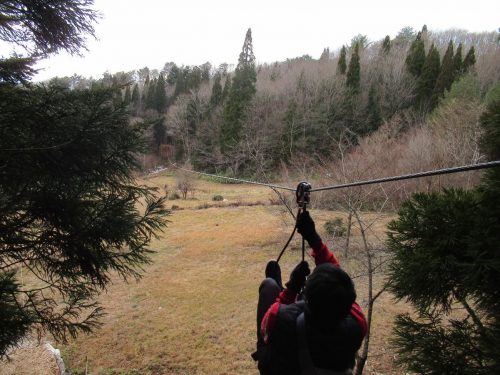
Alternative Activities
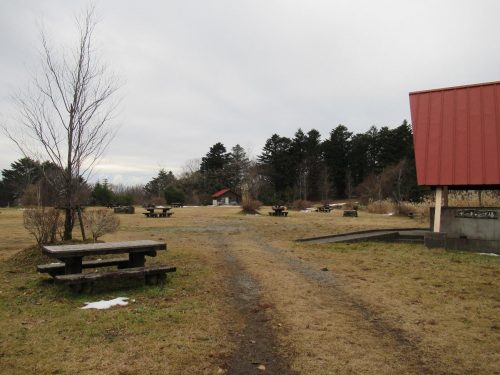
Those who have done Forest Adventure (or simply don’t wish to) still have a slew of things to do in this park. For one, the hiking trail for Mt. Komuroi starts part way up the hill from the Mominoki Villa, and in better weather, I might try that myself. There’s also a day campground full of picnic tables and barbecue pits, perfect for family cookouts and group events. If all that wasn’t enough for you, visitors longing for something active can make use of the tennis courts, cycling road, playground, and sports grounds to move their bodies in any way imaginable, all in the great outdoors!
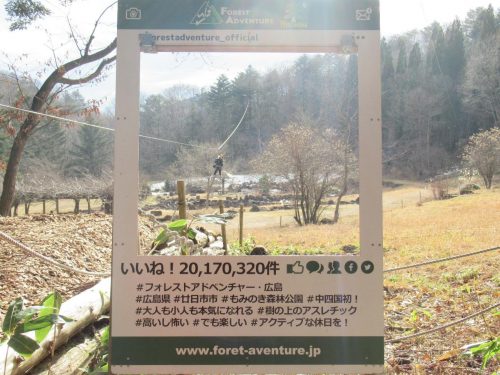
Mominoki Forest Park as a whole offers enough options to justify multiple visits throughout the year, especially when factoring in the changing of the seasons. As I came in winter, the things I could participate in were limited, but if I have the chance to return here (preferably with a friend who drives) I’d like to pack my schedule full of activities. Guests who want to make the most of their time would do well to spend the night at the Mominoki Villa to enjoy the nature here and worry less about transportation. With so much to do and so many photogenic spots, it’s a shame that mountainous Hatsukaichi isn’t as famous as maritime Hatsukaichi. There’s a whole new side to “Miyajima’s city” waiting to be uncovered at this park, so brave adventurers seeking thrills ought to zip up here for some forested fun!






